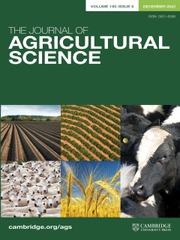Article contents
Global corn area from 1960 to 2030: patterns, trends and implications
Published online by Cambridge University Press: 27 February 2025
Abstract
The study analysed corn harvested areas from 1960 to 2030, using data from the USDA open-access official dataset and 1000 autoregressive integrated moving average models. The global corn harvested area experienced a steady growth rate of 1.0 % in the 1960s, followed by a slight setback in the 1980s and a recovery in the 1990s. The early 2000s saw significant expansion, while the 2010s saw a slightly slower pace of 1.4 %. From 2020 to 2024, the global growth rate declined to 0.0 %, suggesting a potential shift towards a more stable or slower growth phase. The most likely scenario for the global corn area is an optimistic outlook with a 37 % likelihood of steady growth. China’s most likely scenario is a gradual expansion with a rate of 2.0 %. The United States’ most likely scenario suggests a neutral trend. Brazil has remarkable growth trajectories in its areas, reflecting land availability. Ukraine’s area by 2030 is projected to experience varying outcomes due to uncertainties in the agricultural landscape.
Information
- Type
- Crops and Soils Research Paper
- Information
- Copyright
- © The Author(s), 2025. Published by Cambridge University Press
References
- 1
- Cited by


